Integrating Spatial Valuation of Ecosystem Services into Protected Area Management: A Case Study of the Cangshan Nature Reserve in Dali, China
Abstract
:1. Introduction
2. Materials and Methods
2.1. Study Area
2.2. Future Land-Use and Land-Cover Prediction
2.2.1. Slow Urbanization Scenario
2.2.2. Moderate Urbanization Scenario
2.2.3. Rapid Urbanization Scenario
2.3. Mapping Ecosystem Services
2.3.1. Water Yield
2.3.2. Nutrient Retention
2.3.3. Model Accuracy
2.4. Analysis of Water Demand from the Reserve
2.5. Selection of the Core Conservation Areas (CCAs)
2.6. Data Sources and Processing
3. Results
3.1. Land-Use Changes from 1995 to 2035
3.2. Water Quantity and Quality in the Reserve
3.3. Spatial Distribution of Core Conservation Areas (CCAs) in the Reserve
4. Discussion
Author Contributions
Funding
Acknowledgments
Conflicts of Interest
Appendix A
| Ecosystem Services | Actual Value | Simulated Value | Relative Error (%) |
|---|---|---|---|
| Water yield (× 108 m3) | 2.23 | 2.25 | 0.9 |
| Nitrogen loads (× 105 kg) | 6.32 | 6.02 | −4.7 |
| Phosphorus loads (× 103 kg) | 4.83 | 4.52 | −6.4 |
| Actual Water Demand in 2015 | Water Demand of MU Scenario under Documents | Prediction Water Demand of MU Scenario | Relative Error (%) | |
|---|---|---|---|---|
| Residential water (× 104 m3) | 593.97 | 1450 | 1392.53 | −3.96 |
| Livestock breeding water (× 104 m3) | 278.24 | 240 | 223.73 | −6.78 |
| Agricultural water (× 104 m3) | 3181.87 | 2662 | 2558.47 | −3.89 |
| Enterprise water (× 104 m3) | 1144.28 | 2542 | 2682.70 | 5.54 |
| The total water demand (× 104 m3) | 5198.36 | 6152.91 | 6857.43 | −0.53 |
Appendix B

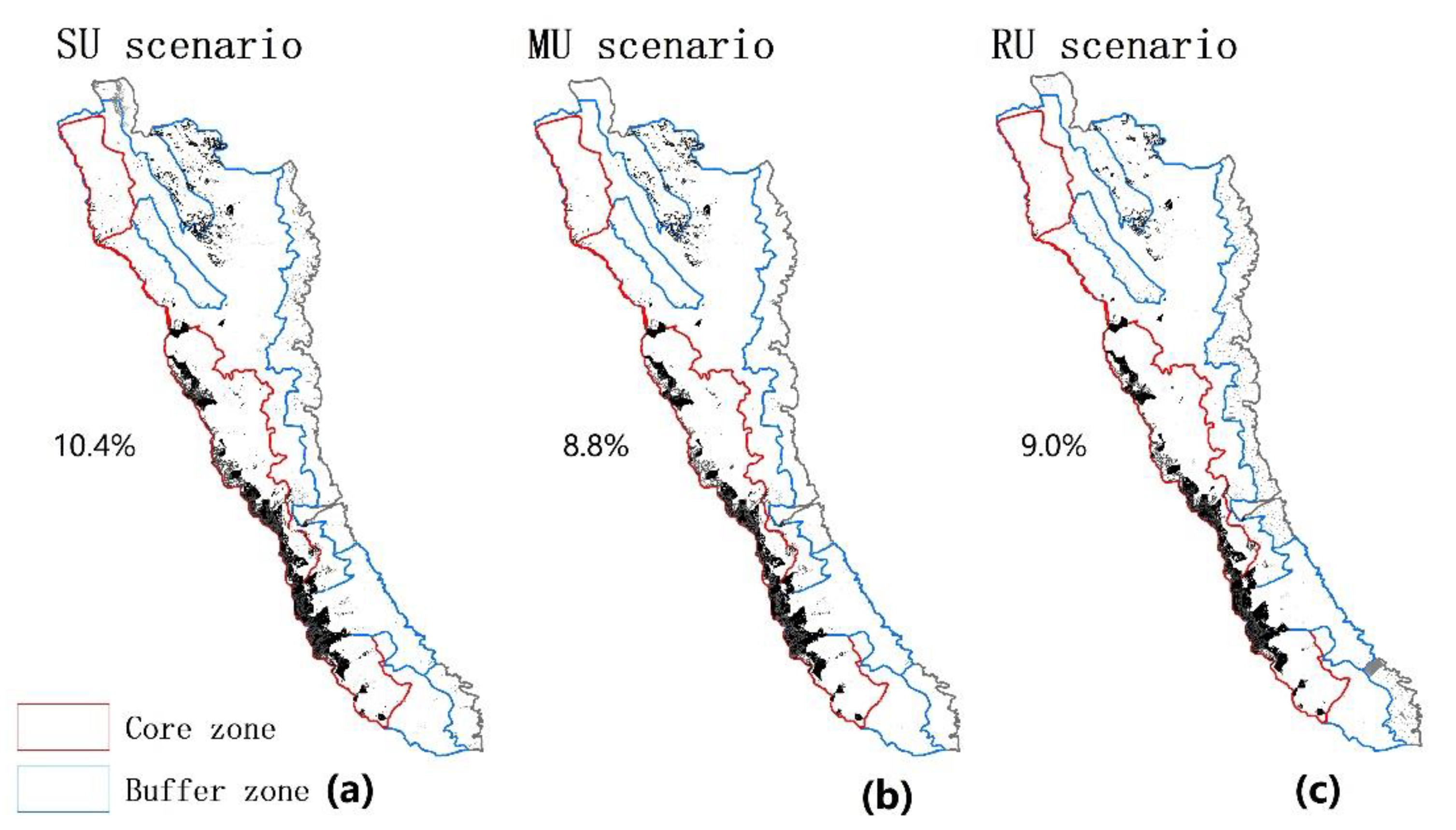

References
- Watson, J.E.; Dudley, N.; Segan, D.B.; Hockings, M. The performance and potential of protected areas. Nature 2014, 515, 67–73. [Google Scholar] [CrossRef] [PubMed]
- Corlett, R.T. Safeguarding our future by protecting biodiversity. Plant Divers. 2020, 42, 221–228. [Google Scholar] [CrossRef] [PubMed]
- Tuanmu, M.-N.; Jetz, W. A global 1-km consensus land-cover product for biodiversity and ecosystem modelling. Glob. Ecol. Biogeogr. 2014, 23, 1031–1045. [Google Scholar] [CrossRef]
- Zafra-Calvo, N.; Garmendia, E.; Pascual, U.; Palomo, I.; Gross-Camp, N.; Brockington, D.; Cortes-Vazquez, J.-A.; Coolsaet, B.; Burgess, N.D. Progress toward Equitably Managed Protected Areas in Aichi Target 11: A Global Survey. BioScience 2019, 69, 191–197. [Google Scholar] [CrossRef] [PubMed]
- Morea, J.P. A framework for improving the management of protected areas from a social perspective: The case of Bahía de San Antonio Protected Natural Area, Argentina. Land Use Policy 2019, 87, 104044. [Google Scholar] [CrossRef]
- Li, J.; Wang, W.; Axmacher, J.C.; Zhang, Y.; Zhu, Y. Streamlining China’s protected areas. Science 2016, 351, 1160. [Google Scholar] [CrossRef] [PubMed]
- Chape, S.; Harrison, J.; Spalding, M.; Lysenko, I. Measuring the extent and effectiveness of protected areas as an indicator for meeting global biodiversity targets. Philos Trans. R. Soc. B Biol. Sci. 2005, 360, 443–455. [Google Scholar] [CrossRef] [Green Version]
- Gong, M.; Fan, Z.; Zhang, X.; Liu, G.; Wen, W.; Zhang, L. Measuring the effectiveness of protected area management by comparing habitat utilization and threat dynamics. Biol. Conserv. 2017, 210, 253–260. [Google Scholar] [CrossRef]
- Lopez-Rodriguez, F.; Rosado, D. Management effectiveness evaluation in protected areas of southern Ecuador. J. Environ. Manag. 2017, 190, 45–52. [Google Scholar] [CrossRef]
- Millennium Ecosystem Assessment. Ecosystems and Human Well-Being; Island Press: Washington, DC, USA, 2005. [Google Scholar]
- Wang, J.; Zhai, T.; Lin, Y.; Kong, X.; He, T. Spatial imbalance and changes in supply and demand of ecosystem services in China. Sci. Total Environ. 2019, 657, 781–791. [Google Scholar] [CrossRef]
- Doak, D.F.; Bakker, V.J.; Goldstein, B.E.; Hale, B. What is the future of conservation? Trends Ecol. Evol. 2014, 29, 77–81. [Google Scholar] [CrossRef] [PubMed]
- Reid, W.V.; Mooney, H.A.; Capistrano, D.; Carpenter, S.R.; Chopra, K.; Cropper, A.; Dasgupta, P.; Hassan, R.; Leemans, R.; May, R.M. Nature: The many benefits of ecosystem services. Nature 2006, 443, 749. [Google Scholar] [CrossRef] [PubMed]
- Cowling, R.M.; Egoh, B.; Knight, A.T.; O’Farrell, P.J.; Reyers, B.; Rouget, M.; Roux, D.J.; Welz, A.; Wilhelm-Rechman, A. An operational model for mainstreaming ecosystem services for implementation. Proc. Natl. Acad. Sci. USA 2008, 105, 9483–9488. [Google Scholar] [CrossRef] [PubMed] [Green Version]
- Graves, R.A.; Pearson, S.M.; Turner, M.G. Species richness alone does not predict cultural ecosystem service value. Proc. Natl. Acad. Sci. USA 2017, 114, 3774–3779. [Google Scholar] [CrossRef] [Green Version]
- Hummel, C.; Poursanidis, D.; Orenstein, D.; Elliott, M.; Adamescu, M.C.; Cazacu, C.; Ziv, G.; Chrysoulakis, N.; van der Meer, J.; Hummel, H. Protected Area management: Fusion and confusion with the ecosystem services approach. Sci. Total Environ. 2019, 651, 2432–2443. [Google Scholar] [CrossRef]
- Lanzas, M.; Hermoso, V.; de-Miguel, S.; Bota, G.; Brotons, L. Designing a network of green infrastructure to enhance the conservation value of protected areas and maintain ecosystem services. Sci. Total Environ. 2019, 651, 541–550. [Google Scholar] [CrossRef]
- Reid, W.V. Millennium Ecosystem Assessment; World Resources Institute: Washington, DC, USA, 2005. [Google Scholar]
- Kumar, P. The Economics of Ecosystems and Biodiversity: Ecological and Economic Foundations; UNEP/Earthprint: Nairobi, Kenya, 2010. [Google Scholar]
- Díaz, S.; Demissew, S.; Carabias, J.; Joly, C.; Lonsdale, M.; Ash, N.; Larigauderie, A.; Adhikari, J.R.; Arico, S.; Báldi, A. The IPBES Conceptual Framework—Connecting nature and people. Curr. Opin. Environ. Sustain. 2015, 14, 1–16. [Google Scholar] [CrossRef] [Green Version]
- Ninan, K.; Kontoleon, A. Valuing forest ecosystem services and disservices—Case study of a protected area in India. Ecosyst. Serv. 2016, 20, 1–14. [Google Scholar] [CrossRef] [Green Version]
- Hein, L. Economic benefits generated by protected areas: The case of the Hoge Veluwe forest, the Netherlands. Ecol. Soc. 2011, 16, 16. [Google Scholar] [CrossRef] [Green Version]
- Min, W.; Xiangzhao, F.; Liang, W.; Qun, G.; Qiurui, Z.; Chunxiu, T. The evaluation of ecological service value in a typical grassland nature reserve under the context of global climate changes. J. Desert Res. 2015, 35, 1700–1707. [Google Scholar]
- Hu, S.; Zhang, L. Study on the Management of the Nature Reserves Based on Evaluation of Ecosystem Service Value in Tibet: A Case of Gongbu Nature Reserve. Prog. Geogr. 2010, 29, 217–224. [Google Scholar]
- Costanza, R.; d’Arge, R.; De Groot, R.; Farber, S.; Grasso, M.; Hannon, B.; Limburg, K.; Naeem, S.; O’neill, R.V.; Paruelo, J. The value of the world’s ecosystem services and natural capital. Nature 1997, 387, 253–260. [Google Scholar] [CrossRef]
- Ludwig, D. Limitations of economic valuation of ecosystems. Ecosystems 2000, 3, 31–35. [Google Scholar] [CrossRef]
- Raymond, C.M.; Singh, G.G.; Benessaiah, K.; Bernhardt, J.R.; Levine, J.; Nelson, H.; Turner, N.J.; Norton, B.; Tam, J.; Chan, K.M. Ecosystem services and beyond: Using multiple metaphors to understand human–environment relationships. BioScience 2013, 63, 536–546. [Google Scholar] [CrossRef] [Green Version]
- Nieto-Romero, M.; Oteros-Rozas, E.; González, J.A.; Martín-López, B. Exploring the knowledge landscape of ecosystem services assessments in Mediterranean agroecosystems: Insights for future research. Environ. Sci. Policy 2014, 37, 121–133. [Google Scholar] [CrossRef]
- Fagerholm, N.; Käyhkö, N.; Ndumbaro, F.; Khamis, M. Community stakeholders’ knowledge in landscape assessments—Mapping indicators for landscape services. Ecol. Indic. 2012, 18, 421–433. [Google Scholar] [CrossRef]
- Brown, G.; Fagerholm, N. Empirical PPGIS/PGIS mapping of ecosystem services: A review and evaluation. Ecosyst. Serv. 2015, 13, 119–133. [Google Scholar] [CrossRef]
- Goldstein, J.H.; Caldarone, G.; Duarte, T.K.; Ennaanay, D.; Hannahs, N.; Mendoza, G.; Polasky, S.; Wolny, S.; Daily, G.C. Integrating ecosystem-service tradeoffs into land-use decisions. Proc. Natl. Acad. Sci. USA 2012, 109, 7565–7570. [Google Scholar] [CrossRef] [Green Version]
- Zank, B.; Bagstad, K.J.; Voigt, B.; Villa, F. Modeling the effects of urban expansion on natural capital stocks and ecosystem service flows: A case study in the Puget Sound, Washington, USA. Landsc. Urban Plan. 2016, 149, 31–42. [Google Scholar] [CrossRef]
- Alarcon, G.G.; Ayanu, Y.; Fantini, A.C.; Farley, J.; Schmitt Filho, A.; Koellner, T. Weakening the Brazilian legislation for forest conservation has severe impacts for ecosystem services in the Atlantic Southern Forest. Land Use Policy 2015, 47, 1–11. [Google Scholar] [CrossRef]
- Sun, X.; Li, F. Spatiotemporal assessment and trade-offs of multiple ecosystem services based on land use changes in Zengcheng, China. Sci. Total Environ. 2017, 609, 1569–1581. [Google Scholar] [CrossRef] [PubMed]
- Fan, M.; Shibata, H. Simulation of watershed hydrology and stream water quality under land use and climate change scenarios in Teshio River watershed, northern Japan. Ecol. Indic. 2015, 50, 79–89. [Google Scholar] [CrossRef]
- Fan, P.F.; Yang, L.; Liu, Y.; Lee, T.M. Build up conservation research capacity in China for biodiversity governance. Nat. Ecol. Evol. 2020, 4, 1162–1167. [Google Scholar] [CrossRef] [PubMed]
- Xu, W.; Pimm, S.L.; Du, A.; Su, Y.; Fan, X.; An, L.; Liu, J.; Ouyang, Z. Transforming Protected Area Management in China. Trends Ecol. Evol. 2019, 34, 762–766. [Google Scholar] [CrossRef] [PubMed] [Green Version]
- Zhang, Y.-B.; Wang, Y.-Z.; Phillips, N.; Ma, K.-P.; Li, J.-S.; Wang, W. Integrated maps of biodiversity in the Qinling Mountains of China for expanding protected areas. Biol. Conserv. 2017, 210, 64–71. [Google Scholar] [CrossRef]
- Tonghui, M.; Cai, L.; Guangchun, L. The spatial overlapping analysis for China’s natural protected area and countermeasures for the optimization and integration of protected area system. Biodivers. Sci. 2019, 27, 758–771. [Google Scholar] [CrossRef]
- Geneletti, D.; van Duren, I. Protected area zoning for conservation and use: A combination of spatial multicriteria and multiobjective evaluation. Landsc. Urban Plan. 2008, 85, 97–110. [Google Scholar] [CrossRef]
- Zhang, Z.; Sherman, R.; Yang, Z.; Wu, R.; Wang, W.; Yin, M.; Yang, G.; Ou, X. Integrating a participatory process with a GIS-based multi-criteria decision analysis for protected area zoning in China. J. Nat. Conserv. 2013, 21, 225–240. [Google Scholar] [CrossRef]
- Lin, J.; Li, X. Conflict resolution in the zoning of eco-protected areas in fast-growing regions based on game theory. J. Environ. Manag. 2016, 170, 177–185. [Google Scholar] [CrossRef]
- Tao, R.; Zhao, Y. Investigation and Analysis of Water Volume of 18-creek in Cangshan Mountain, Dali, Yunnan. Yangtze River 2015, 46, 44. [Google Scholar]
- Zhai, Y.; Zhou, C.; Liu, C. An analysis on the spatial and temporal distribution of precipitation of eighteen creeks’ watershed in Cangshan Mountain. J. Yunnan Univ. (Nat. Sci. Ed.) 2017, 39, 618–623. [Google Scholar] [CrossRef]
- Sharp, R. InVEST User Guide—InVEST 3. 7. 0 Documentation; The Natural Capital Project, Stanford University: Stanford, CA, USA; University of Minnesota: Minneapolis, MN, USA, 2018. [Google Scholar]
- He, C.; Zhang, D.; Huang, Q.; Zhao, Y. Assessing the potential impacts of urban expansion on regional carbon storage by linking the LUSD-urban and InVEST models. Environ. Model. Softw. 2016, 75, 44–58. [Google Scholar] [CrossRef]
- Zhai, Y.; Zhou, C.; Liu, C. Allocation and Management of Water Resource from the Perspective of Water Rights—A Case Study of Cangshan Eighteen Creeks. J. Kunming Univ. Sci. Technol. (Nat. Sci. Ed.) 2017, 42, 136–144. [Google Scholar] [CrossRef]
- EPBPRC. Environmental Quality Standards for Surface Water 2002, (GB 3838-2002); Environmental Protection Bureau: Beijing, China, 2002. [Google Scholar]
- Jin, Y.; Zhu, Y.; Wang, W. Changes of Ecosystem Service Functions of Dali Bai Autonomous Prefecture in Yunnan Province. Ecol. Econ. 2016, 32, 130–134. [Google Scholar]
- Zhai, Y.; Liu, C. Evaluation of Function of Aquatic Ecosystem and Its Economic Value in Eighteen Creeks of Cangshan. China Rural Water Hydropower 2015, 5, 77–80. [Google Scholar] [CrossRef]
- Arkema, K.K.; Verutes, G.M.; Wood, S.A.; Clarke-Samuels, C.; Rosado, S.; Canto, M.; Rosenthal, A.; Ruckelshaus, M.; Guannel, G.; Toft, J. Embedding ecosystem services in coastal planning leads to better outcomes for people and nature. Proc. Natl. Acad. Sci. USA 2015, 112, 7390–7395. [Google Scholar] [CrossRef] [Green Version]
- Tammi, I.; Mustajärvi, K.; Rasinmäki, J. Integrating spatial valuation of ecosystem services into regional planning and development. Ecosyst. Serv. 2017, 26, 329–344. [Google Scholar] [CrossRef] [Green Version]
- Sun, X.; Zhang, Y.; Shen, Y.; Randhir, T.O.; Cao, M. Exploring ecosystem services and scenario simulation in the headwaters of Qiantang River watershed of China. Environ. Sci. Pollut. Res. Int. 2019, 26, 34905–34923. [Google Scholar] [CrossRef]
- Chen, B.; Liu, F.; Wang, W.; Li, J. Assessment of forest conservation in the Cangshan Nature Reserve based on propensity score matching. Biodivers. Sci. 2017, 25, 999–1007. [Google Scholar] [CrossRef] [Green Version]
- Delphin, S.; Escobedo, F.; Abd-Elrahman, A.; Cropper, W. Urbanization as a land use change driver of forest ecosystem services. Land Use Policy 2016, 54, 188–199. [Google Scholar] [CrossRef] [Green Version]
- Sun, X.; Crittenden, J.C.; Li, F.; Lu, Z.; Dou, X. Urban expansion simulation and the spatio-temporal changes of ecosystem services, a case study in Atlanta Metropolitan area, USA. Sci. Total Environ. 2018, 622, 974–987. [Google Scholar] [PubMed]
- Hull, V.; Xu, W.; Liu, W.; Zhou, S.; Viña, A.; Zhang, J.; Tuanmu, M.-N.; Huang, J.; Linderman, M.; Chen, X.; et al. Evaluating the efficacy of zoning designations for protected area management. Biol. Conserv. 2011, 144, 3028–3037. [Google Scholar] [CrossRef]
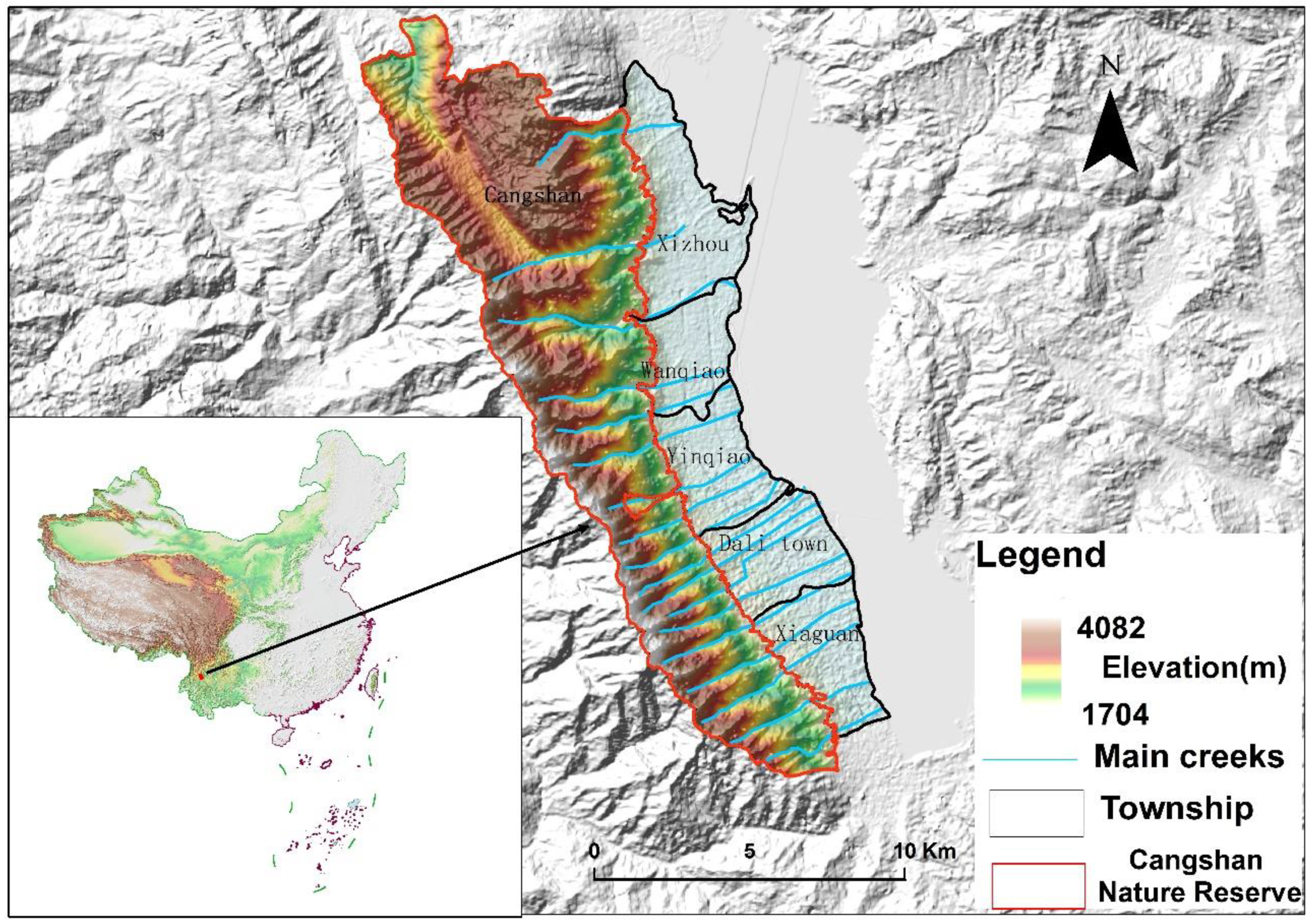
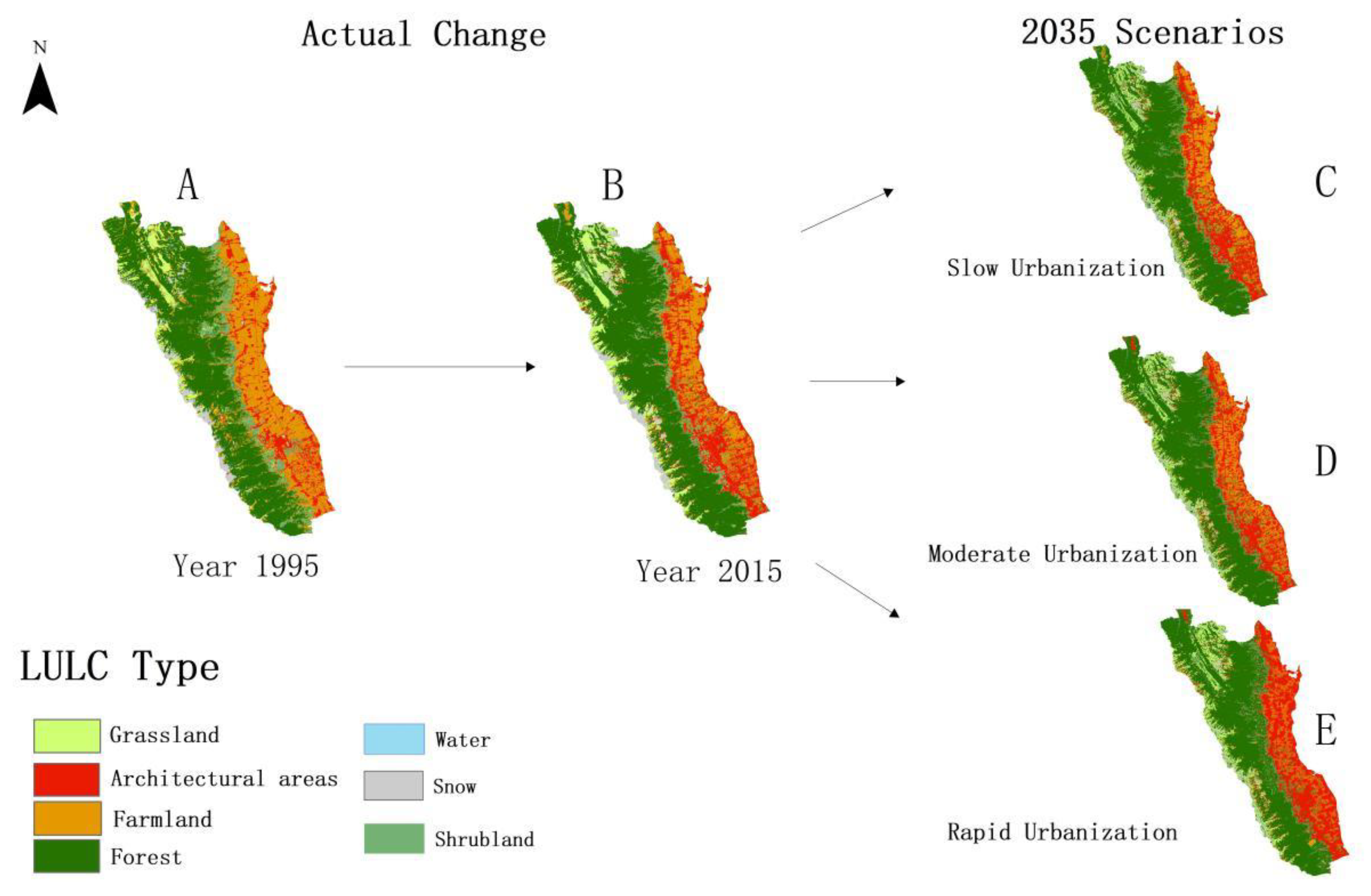
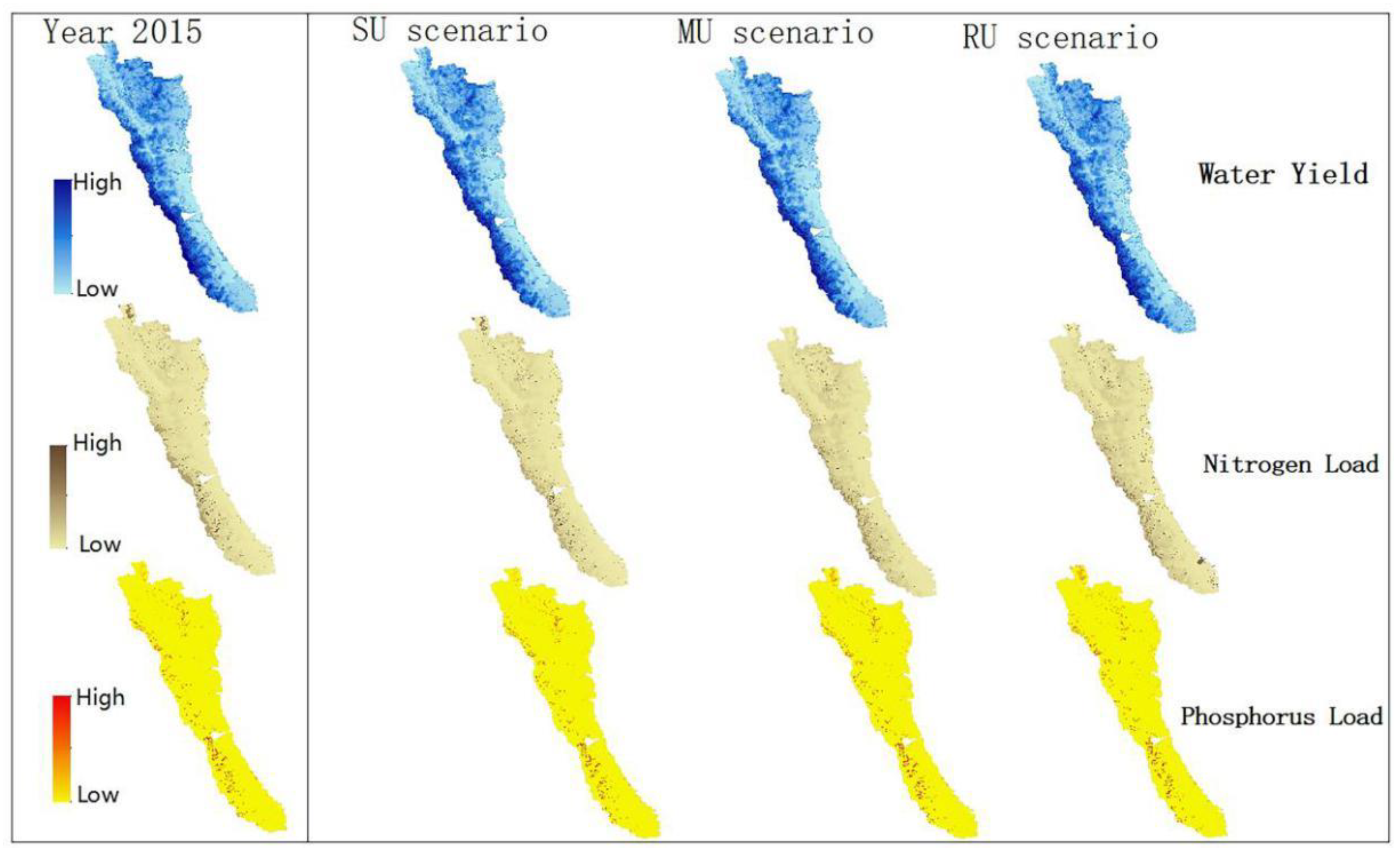
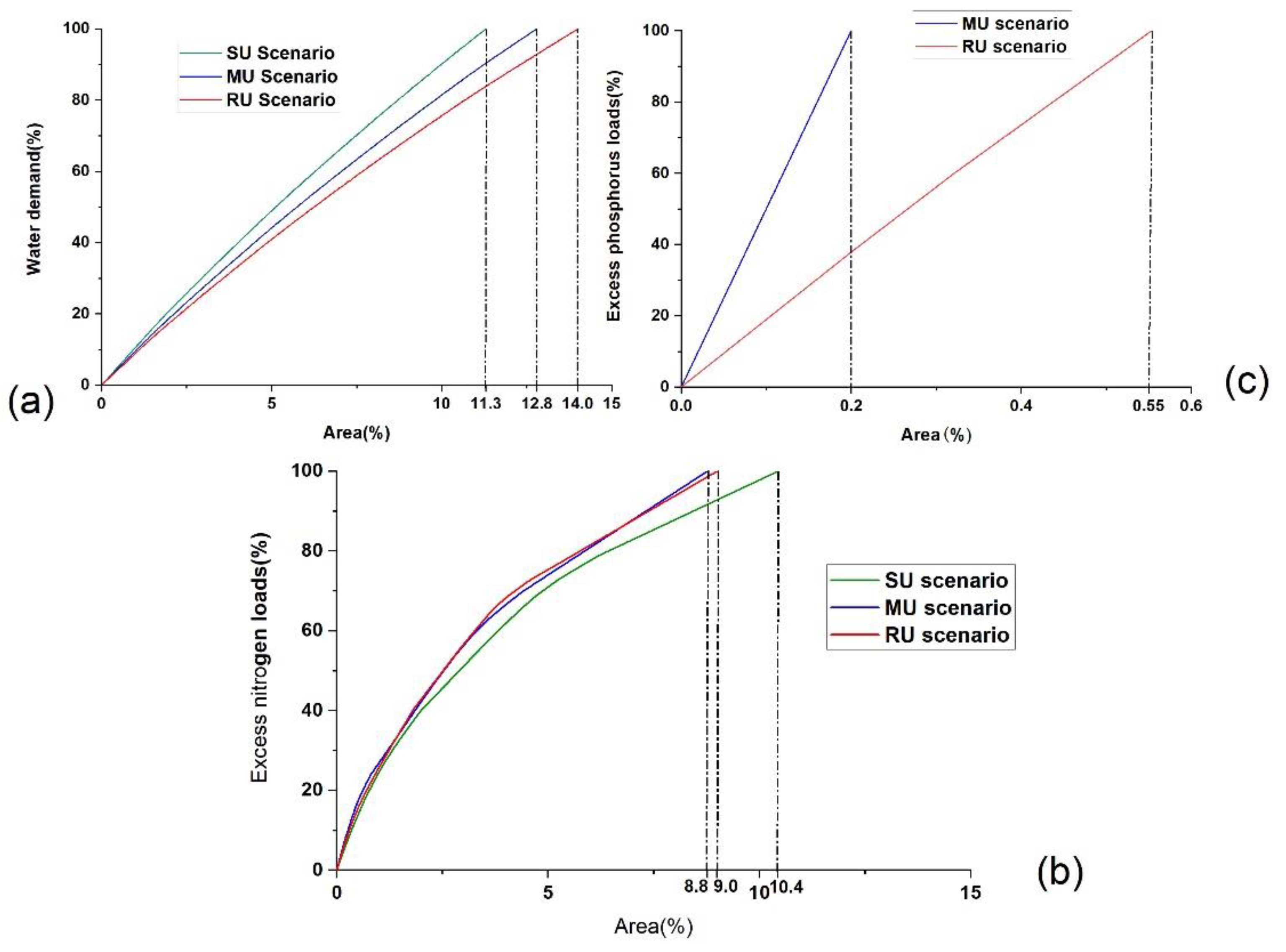

| 1995 | 2015 | 2035 SU | 2035 MU | 2035 RU | |
|---|---|---|---|---|---|
| The urban population (K) | 30.6 | 97.5 | 153.7 | 192.8 | 265.7 |
| Total population (K) | 170.0 | 191.2 | 213.6 | 232.1 | 295.2 |
| Urbanization rate (%) | 18 | 51 | 72 | 83 | 90 |
| Residential Water (× 104 m3) | Livestock Breeding Water (× 104 m3) | Agricultural Water (× 104 m3) | Enterprise Water (× 104 m3) | The Total Water Demand (× 104 m3) | Excess N Loads (kg) | Excess P Loads (kg) | |
|---|---|---|---|---|---|---|---|
| 2015 | 593.97 | 278.24 | 3181.87 | 1144.28 | 5198.36 | - | - |
| 2035 SU | 1050.39 | 247.59 | 2831.37 | 2023.56 | 6152.91 | 13,725.75 | - |
| 2035 MU | 1392.53 | 223.73 | 2558.47 | 2682.70 | 6857.43 | 9613.60 | 283.55 |
| 2035 RU | 1984.78 | 129.31 | 1478.73 | 3823.67 | 7416.49 | 10,152.54 | 854.17 |
| 2015 | 2035 SU | 2035 MU | 2035 RU | |
|---|---|---|---|---|
| Water yield (× 108 m3) | 2.25 | 2.23 | 2.25 | 2.29 |
| Nitrogen loads (× 105 kg) | 6.02 | 5.83 | 5.45 | 5.59 |
| Phosphorus loads (× 103 kg) | 4.52 | 4.36 | 4.78 | 5.43 |
| Average nitrogen content (mg/L) | 0.267 | 0.262 | 0.243 | 0.244 |
| Average Phosphorus content (mg/L) | 0.0200 | 0.0196 | 0.0213 | 0.0237 |
| LULC | 1995 Area (ha) (%) | 2015 Area (ha) (%) | 2035 SU Area (ha) (%) | 2035 MU Area (ha) (%) | 2035 RU Area (ha) (%) |
|---|---|---|---|---|---|
| Grassland | 2439.99 (5.49) | 3770.46 (8.49) | 3322.44 (7.48) | 3558.15 (8.01) | 3809.70 (8.58) |
| Architectural areas | 4079.07 (9.19) | 7529.58 (16.96) | 8253.90 (18.59) | 8904.15 (20.05) | 11,636.28 (26.21) |
| Farmland | 12,759.03 (28.73) | 7015.86 (15.80) | 6243.03 (14.06) | 5641.29 (12.70) | 3260.52 (7.34) |
| Forest | 20,128.95 (45.33) | 21,625.83 (48.70) | 23,352.84 (52.59) | 23,549.40 (53.03) | 22,792.32 (51.33) |
| Water | 98.19 (0.22) | 67.50 (0.15) | 67.50 (0.15) | 56.25 (0.13) | 12.06 (0.03) |
| Snow | 1467.99 (3.31) | 1701.99 (3.83) | 1238.04 (2.79) | 1056.33 (2.38) | 793.53 (1.79) |
| Shrubland | 3431.52 (7.73) | 2693.52 (6.07) | 1926.99 (4.34) | 1639.17 (3.69) | 2100.33 (4.73) |
| Total | 44,404.74 (100) | ||||
Publisher’s Note: MDPI stays neutral with regard to jurisdictional claims in published maps and institutional affiliations. |
© 2020 by the authors. Licensee MDPI, Basel, Switzerland. This article is an open access article distributed under the terms and conditions of the Creative Commons Attribution (CC BY) license (http://creativecommons.org/licenses/by/4.0/).
Share and Cite
Xia, J.; Cao, M.; Xiao, W.; Li, Y.; Fu, G.; Wang, W.; Li, J. Integrating Spatial Valuation of Ecosystem Services into Protected Area Management: A Case Study of the Cangshan Nature Reserve in Dali, China. Sustainability 2020, 12, 9395. https://doi.org/10.3390/su12229395
Xia J, Cao M, Xiao W, Li Y, Fu G, Wang W, Li J. Integrating Spatial Valuation of Ecosystem Services into Protected Area Management: A Case Study of the Cangshan Nature Reserve in Dali, China. Sustainability. 2020; 12(22):9395. https://doi.org/10.3390/su12229395
Chicago/Turabian StyleXia, Juyi, Ming Cao, Wen Xiao, Yanpeng Li, Gang Fu, Wei Wang, and Junsheng Li. 2020. "Integrating Spatial Valuation of Ecosystem Services into Protected Area Management: A Case Study of the Cangshan Nature Reserve in Dali, China" Sustainability 12, no. 22: 9395. https://doi.org/10.3390/su12229395





